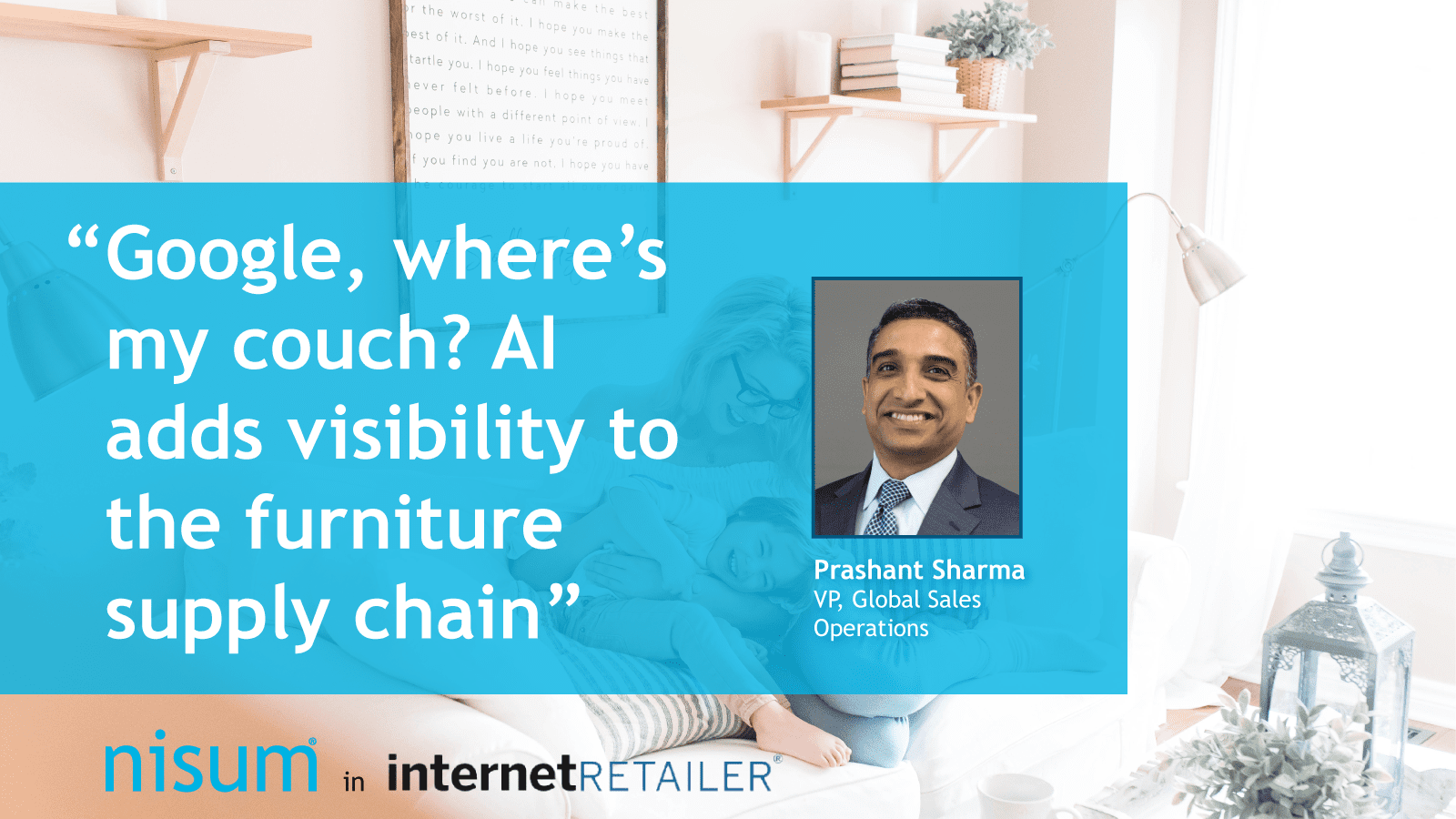Nisum’s VP of Global Sales Operations, Prashant Sharma, talks about how artificial intelligence and machine learning are playing an important role in boosting online furniture sales in his Internet Retailer article. Read the text below or see the full article here.

Google, where’s my couch? AI adds visibility to the furniture supply chain
Consumers are increasingly comfortable buying furniture online, but the complexity of the supply chain in this category makes it hard for retailers to say confidently when they can deliver a product. Here is how artificial intelligence can help.
No one demands supply chain visibility more urgently than a consumer who has just placed an online order and is waiting for it to arrive. Most retailers for smaller items (think: apparel, beauty, electronics, food, and pantry, etc.) have figured this out. They make sure the customer receives multiple updates regarding when their order is confirmed and shipped, and a postal tracking number allows the consumer to monitor their order right up until the moment it lands on their doorstep.
This kind of on-demand transparency has seeped into the cracks of our everyday life. Thanks to Uber and Lyft, a person running late for an important meeting can request a car and immediately track their journey, from knowing exactly when the car will arrive to when it will drop them off at their destination. The same goes for food delivery services, like Seamless or Caviar; eaters are able to track their food from preparation to delivery.
It may seem counterintuitive, then, that while consumers can track, in real-time and with great accuracy, the status of their Sunday brunch, the same isn’t true for some of the largest, most expensive purchases that they make: furniture.
For furniture, and other larger items comprised of many parts and made by many different manufacturers, supply chain visibility has remained foggy at best. This is not necessarily surprising. Consumers are just now becoming comfortable with buying furniture online. This kind of purchase is a major investment, and people want to see, touch, and feel it before making a final decision. On the retailer side, furniture is bulky and expensive to ship, return and restock, especially as parts are coming from many different factory locations.
However, the sector represents a major opportunity for retailers who can get it right. According to eMarketer, eCommerce sales of furniture and home furnishings accounted for 21% of total retail sales in 2018. By 2023, eMarketer predicts it will account for nearly a third. In dollars, retail eCommerce from furniture and home furnishing sales reached $65.1 billion last year and are projected to reach nearly $100 billion within the next three years.
Supply chain challenges
Providing visibility into the supply chain will be a key differentiator for furniture retailers in capturing this nascent market, and advances in machine learning are making this increasingly possible.
Consider the many data streams that must converge in delivering furniture to a consumer. Materials are coming from many different manufacturers in many different countries. Each cushion, connector joint, table leg, etc. must make its way to a central warehouse location and packaged to ship in the appropriate groupings. With so many different inputs and so many variables impacting the status of each, it’s no wonder that the average delivery window for a new living room set can range anywhere from four to 12 weeks.
Machine learning enables retailers to organize these disparate data sources in more efficient ways that in turn, allow consumers to have a more exact idea of when they can expect their purchase.
For example, predictive analytics built on machine learning can enable demand forecasting with an unprecedented level of precision. These models can uncover demand patterns that have been hiding just below the surface of historical data that just haven’t yet been connected in the right way.
We know that seasonality tends to play a role in furniture demand—July 4th, Columbus Day, Labor Day, and Memorial Day all tend to see seasonal promotions that drive purchases. But what about weather patterns? If retailers know that certain weather patterns drive or decrease demand, they’re better able to predict needed inventory levels. If they’re able to place manufacturer orders ahead of time, customers suddenly have a shorter—and much more transparent—delivery window.
For want of a nail…
To share another example, furniture retailers need to track and monitor hundreds of thousands of component parts in order to ensure items are delivered in their entirety to customers. One supplier that is late with a small but crucial part for a sofa, for example, can delay delivery for weeks. And not knowing when that part will arrive at the warehouse leaves the customer and the retailer completely in the dark.
Machine learning can track the performance of all of a furniture retailer’s suppliers to reveal those that deliver on time or late, allowing retailers to not only optimize but also better inform consumers of their expected wait time.
These are just some specific examples of how AI can introduce a greater degree of visibility into the supply chain for consumers by uncovering new patterns and connections within data. However, it doesn’t end there. Machine learning is also giving consumers new ways to digitally “try before they buy” furniture with 3D imaging, 360 viewings, and even the capability to model how certain furniture would fit and look in their home.
As technology becomes more sophisticated, consumers will become increasingly comfortable making big-ticket purchases online. Giving them greater visibility into where their items are is only the first step.



